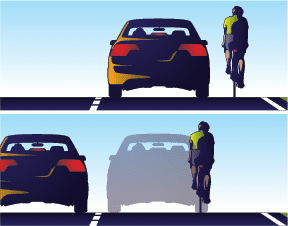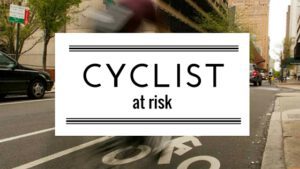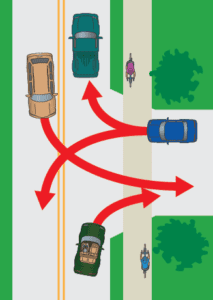In Florida, the bicycle is legally defined as a vehicle and the bicyclist is a driver. Bicyclists have the same rights to the roadways, and must obey the same traffic laws as the drivers of other vehicles. These laws include stopping for stop signs and red lights, riding with the flow of traffic, using lights at night, yielding the right-of-way when entering a roadway and yielding to pedestrians in crosswalks.
Riding a bike is a healthy, fun and safe activity. However, it isn’t without some risk. As a personal injury lawyer, Zarzaur Law has dealt with a number of cases recently surrounding the cyclist and automobiles, path regulations and cyclist risk factors in the environment.
Zarzaur Law firm of Pensacola, FL focuses on all areas of personal injury – but has a special interest in athletic injuries. Personal Injury Lawyer, Joe Zarzaur and board certified doctor, and firm medical official, Dr. Evan Malone are triathletes and competitive Ironman contestants. Cyclist injuries and accidents are a topic that hit close to home, with both gentlemen being at risk in races and everyday training.
Did you know that every 6 hours a cyclist is fatally injured in an accident? Or that of those fatalities, 50% occur in children under the age of sixteen?
The following information highlights the law surrounding the development of public areas that may minimize that risk and have the potential to reduce conflicts between bikes and cars (and other traffic).
All laws & policies mentioned here were compiled as part of a research project for a case handled in the spring of 2016 by Joe Zarzaur and Zarzaur Law. They may be subject to change. Please help us keep them up to date by contacting clerk@zarzaurlaw.com with any updates.
Federal Policy
The Federal Highway Administration’s (FHWA) official policy is to give “full consideration” during the development of federal aid highway projects (e.g. bridges) to the safe accommodation of bicyclists and pedestrians, to make every effort to minimize detrimental effects of current and anticipated pedestrian and/or bicycle traffic, and to encourage consulting with local groups of organized bicyclists regarding bicycle-related projects. 23 C.F.R. § 652.5.
Federal Bicycle/Pedestrian Path Safety and Maintenance Regulations
Federal standards for construction and design of bicycle routes are established by The American Association of State Highway and Transportation Officials’ Guide for Development of New Bicycle Facilities (AASHTO Guide) or equivalent guides developed in cooperation with State or local officials and acceptable to the FHWA. According to the literature therein, the purpose of the AASHTO Guide is to accommodate and encourage bicycling by providing “safe, convenient, well-designed, well-maintained facilities, with low-crash frequencies and severities.” (AASHTO Guide § 1.2) AASHTO’s policy extends to roadways and bridges which should accommodate bicycles. (§ 4.12.3) Throughout the AASHTO Guide, the agency reaffirms local departments of transport’s (DOT) duties to monitor and remedy unsafe conditions on bicycle paths. Given the severity of injuries that may be sustained by cyclists, the Guide calls for increased awareness and responsiveness in addressing bicycle path issues. “Due to bicycle operator’s physical exposure and the unique characteristics of their vehicle,” AASHTO states,”bicyclists are susceptible to severe injury in even minor incidents.” Thus, maintenance and safety protocols are prioritized as a leading concern regarding bicycle paths.

Most close passing is a result of the motorist thinking he can squeeze past without changing lanes. Make sure a driver can clearly see that his car won’t fit within the same lane.
Safety considerations include quality of service evaluations (or Bicycle Level of Service (LOS)) used to evaluate existing bicycling conditions. (AASHTO Guide § 2.62). Implementation of LOS studies includes documenting various factors of existing roadways and paths including pavement surface condition. According to § 4.2, “surface condition and pavement smoothness are important to bicyclist control and comfort . . . Gravel roads, loose material, cracks, bumps, and potholes on a paved roadway create an impediment for bicyclists.” Therefore, safety and maintenance evaluations of existing bicycle paths should monitor surface conditions as a component of LOS studies. LOS measurement is then used to evaluate bicyclists’ perceived safety and comfort while traveling in a roadway corridor. (§ 2.62). AASHTO further stipulates that the detailed knowledge of local bicyclists and bicycle planners should be used to corroborate Bicycle LOS model results. (§ 2.62). This emphasis on utilizing local bicyclists in the safety coordination is reiterated in § 2.6.7 which states that community bicyclists have the best knowledge of current conditions as well as opinions on areas that need improvement.
While there are no bicycle-specific designs or dimensions for shared roadways, the AASHTO Guide states that special care should be exercised to install bicycling compatible features, such as good pavement and bicycle-compatible bridge expansion joints, and that such features should be implemented where they are not present. (§§ 4.3, 5.28). Further, bike lanes should have a “smooth riding surface.” (§ 4.6.1). In order to ensure bike lane smoothness, utility covers should be adjusted flush with the surface of the lane and drainage should be utilized to prevent debris accumulation and potential hazards for bicyclists. (§ 4.6.1). Additionally, AASHTO encourages state-level agencies to development maintenance protocols that include regular sweeping of bikeways (§ 7.2.1), inspections of bikeways for surface repairs (§ 7.2.2), and corrections of pavement overlay drop-offs (§ 7.2.3).
Furthermore, the FHWA provides training and informational materials titled Federal Highway Administration University Course on Bicycle and Pedestrian Transportation that details bicycle and pedestrian path safety precautions that should be exercised by state-level departments of transportation. “Lesson 16” specifically addresses bike path maintenance and states that bicycles and cyclists are “particularly sensitive to maintenance problems.” (§ 16.2). The FHWA course highlights bicyclist safety concerns related to uneven paths: “ridges, such as those found where a new asphalt overlay does not quite cover the older roadway surface, can catch a wheel, and throw a bicyclist to the ground.” (§ 16.2). Section 16.4 describes the objectives of bicycle path maintenance plans and lists roadway surface patching and pavement overlays that “feathers” the new surface as primary objectives.
Implementation procedures involve routine inspection and repair, as well as the development of an “ongoing spot improvement plan” in which the bicycling community is solicited for suggestions and maintenance requests. (§ 16.7). Lastly, FHWA University training lists common issues associated with bicycle paths. Amongst these are ridges and cracks which “should be filled or ground down as needed to reduce the chance of a bicyclist catching a front wheel and crashing.” (§ 16.8).
Federal Statutes
Similarly, federal statutes pertaining to the construction and maintenance of bicycle routes along highways emphasize a heightened duty of care for ensuring the safe travel of bicyclists. According to 23 U.S.C. § 217(d), states receiving FHWA funding under §§ 104(b)(2) and 104(b)(3) shall use such amount of the apportionment as may be necessary to fund the State department of transportation (DOT) a position of bicycle and pedestrian coordinator for promoting and facilitating the increased use of non-motorized modes of transportation, including developing facilities for the use of pedestrians and bicyclists and public education, promotional, and safety programs for using such facilities (§§ 104(b)(2) and 104(b)(3) refer to the Surface Transportation Block Grant Program and Highway Safety Improvement program, respectively).
Moreover, 23 U.S.C. §§ 217(g)(1) and (g)(2) detail planning, design, and safety considerations regarding bicyclist and pedestrian paths. Generally, bicyclists and pedestrians shall be given due consideration in the comprehensive transportation plans developed by each metropolitan planning organization and State in accordance with §§ 134 and 135 (metropolitan transportation planning). Bicycle transportation facilities and pedestrian walkways shall be considered, where appropriate, in conjunction with all new construction and reconstruction of transportation facilities, except where bicycle and pedestrian use are not permitted. § 217(g)(1). Furthermore, transportation plans and projects must provide due consideration for safety and contiguous routes for bicyclists and pedestrians, including the installation, where appropriate, and maintenance of audible traffic signals and audible signs at street crossings. § 217(g)(2).
Federal Bridge Regulations
Where a highway bridge deck, on which bicycles are permitted to operate at each end of such bridge, is replaced or rehabilitated with federal financial participation, and the Secretary determines that the safe accommodation of bicycles can be provided at reasonable cost as part of such replacement or rehabilitation, then such bridge shall be so replaced or rehabilitated as to provide such safe accommodations. 23 U.S.C. 217(e). Bridge inspection procedures are governed by AASHTO Manual guidelines. 23 C.F.R. § 650.313. The AASHTO Maintenance Manual for Roadways and Bridges describes broad guidelines to be followed by state DOT’s. Section 3.2.7.3 of the manual includes bridge inspection procedures.
As related to the instant case, the section includes procedures for the inspection of bridge “approaches.” According to the AASHTO Maintenance Manual, approaches are an adjunct to a bridge and should be level with the bridge deck. Failure to maintain a smooth transition between the approach and the structure allows for additional impact loads on the bridge that can cause extensive structural damage over time. Thus, AASHTO suggests that approach pavement conditions be checked for “unevenness, settlement, or roughness.” The presence of cracking and/or unevenness may indicate a void under the slab caused by fill settlement or erosion. Also, joints between the approach pavement and the abutment back wall, which are designed for thermal movement, should be examined to determine if there is adequate clearance and a proper seal. Shoulders, slopes, drainage, and approach guardrails should also be evaluated as part of the inspection of the approaches, as per AASHTO guidelines. (§ 3.2.7.3).
State-Level Regulations
Statewide transportation plans and improvement programs must provide for the development and integrated management and operation of bicycle transportation facilities. 23 U.S.C. § 135(a)(2). The Florida Department of Transportation’s Manual of Uniform Minimum Standards for Design, Construction, and Maintenance for Streets and Highways (Florida Green Book) contains standards relevant to the instant case.
Get the legal advice you need from experienced lawyer Joe Zarzaur, hassle and commitment free. All consultations are free of charge and there is NO FEE unless you win.
Joe is a pure contingency fee lawyer and only collects costs and fees if he wins the case and the client receives a recovery. If the client does not collect, Joe doesn’t collect either. Call now 855-HIRE_JOE
Telephone: 850-444-9299
Email: info@zarzaurlaw.com
Follow us on Twitter: @zarzaurlaw
Like us on Facebook: https://www.facebook.com/zarzaurlaw
Check us out on Google+: https://plus.google.com/+ZarzaurLawPensacola


